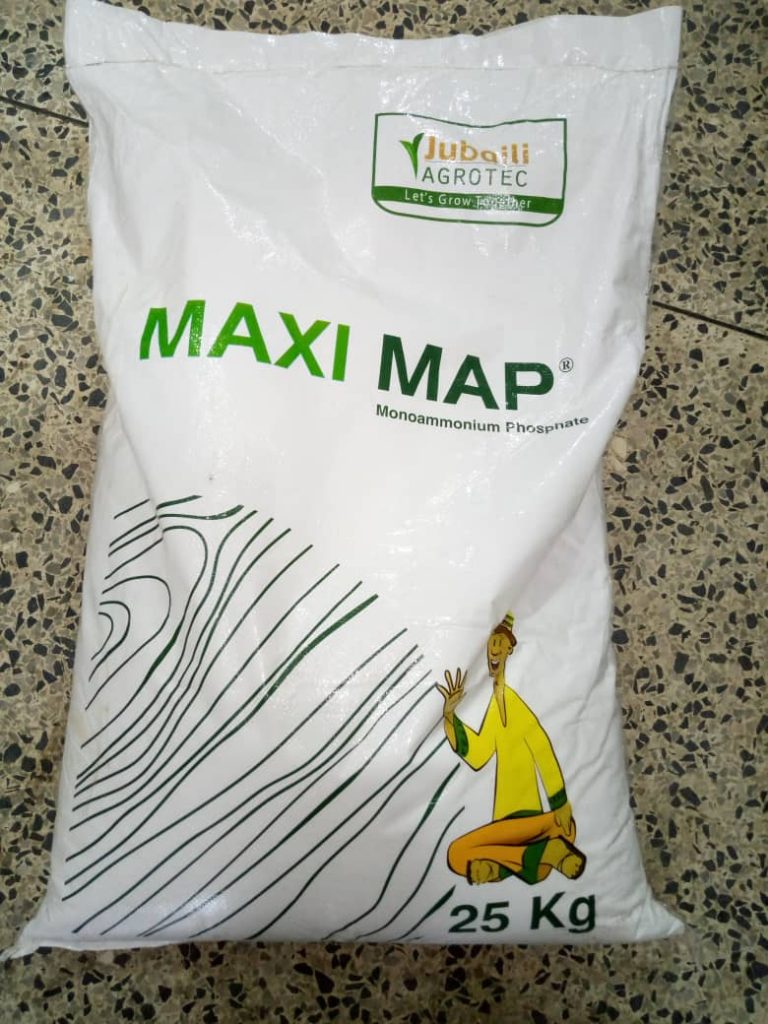No products in the cart.
Return To Shop
0
₦0.00
0
Shopping cart (0)
Subtotal: ₦0.00
Spend ₦500.00 to get free shipping Congratulations! You've got free shipping.
Log in / Sign up
Login Register
Maxi Magna S (Magnesium Sulfat...
₦54,999.00


Maxi MOP (Potassium Chloride F...
₦37,000.00
Maxi MAP (Monoammonium Phosphate Fertilizer)
₦52,000.00
Maxi MAP (Monoammonium Phosphate Fertilizer) is a highly effective fertilizer that provides plants with the essential nutrients phosphorus and nitrogen. It is a good choice for a wide range of crops and can be applied using a variety of methods.
- Monoammonium phosphate (MAP) is a widely used source of phosphorus (P) and nitrogen (N). It contains the most phosphorus of any common solid fertilizer.
- In addition to optimizing efficiency, it also reduces the risk of crop yield and quality loss.
- It is usually applied by broadcasting or during sowing.
- Suitable crops are sugar beet, perenni
20 people are viewing this product right now
Please, activate Compare option to use this widget.
SKU: maxi-map-monoammonium-phosphate-fertilizer-25kg Categories: Fertilizer Tags: Fertilizer, MAP, Maxi, Monoammonium, Phosphate
Estimated delivery:4 days
Share:
Maxi MAP (Monoammonium Phosphate Fertilizer)
Maxi MAP (Monoammonium Phosphate Fertilizer) is the best solid granular fertilizer to provide your crops with phosphorus and nitrogen. These two nutrients are vital for quick sprouting and vegetation.
- Ammonia nitrogen contributes to better phosphorus intake by plants.
- They are offered in 25kg bags.
Advantages/features
- High cropping
- Ensures good root system growth
- Yields high-quality plant products
- Method of application: Broadcasting, during sowing
- Soils: alkaline soils
- Crops: Sugar beet, perennial grasses, grain corn, silage corn, oats, rye, potatoes, sunflower, soybeans, rapeseed, wheat, and others.
How Phosphorus is Obtained
- It is chiefly obtained from mining phosphate rock and naturally from the soil composition.
- The phosphate rock can be exposed to different acids to make the ingredients required for fertilizer.
- High amounts of these nutrients can be obtained artificially from manufactured fertilizers. Our Maxi MAP is your best choice, and bet.
Management practices
- No special precautions are needed with the use of MAP. The slight acidity associated with this fertilizer reduces the potential for NH₃ loss to the air.
- MAP can be placed near germinating seeds without concern for NH₃ damage. However, the MAP used in foliar spray or added to irrigation water shouldn’t be mixed with calcium or magnesium fertilizers.
- MAP has good storage and handling properties. Some of the chemical impurities (such as iron and aluminum) naturally serve as a conditioner to prevent caking.
- As with all P fertilizers, employ appropriate management practices to minimize any nutrient loss to surface or drainage water.
- A high-purity source of MAP is used as a feed ingredient for animals. The NH₄⁺ is synthesized into protein and the H₂PO₄⁻ supports a variety of metabolic functions in animals.
Frequently Asked Questions (FAQs)
What is Maxi MAP and what does it do?
Maxi MAP is a granular fertilizer containing Monoammonium Phosphate (MAP), a source of readily available phosphorus (P) and nitrogen (N) for plants. These nutrients are crucial for early plant growth and establishment.
What are the benefits of using Maxi MAP?
- Promotes strong root development: Maxi MAP contributes to healthy root system growth, vital for nutrient and water uptake.
- Increases crop yields: By providing essential nutrients, Maxi MAP can potentially improve overall crop yields.
- Enhances plant quality: Maxi MAP may contribute to the production of high-quality fruits, vegetables, or other plant products.
How do I apply Maxi MAP fertilizer?
Maxi MAP can be applied using two primary methods:
- Broadcasting: Spread the fertilizer evenly over the soil surface before planting.
- During sowing: Apply Maxi MAP directly during the seeding process, placing it near the seeds.
What types of soil is Maxi MAP suitable for?
Maxi MAP is particularly beneficial in alkaline soils where phosphorus availability for plants might be limited.
What crops can benefit from Maxi MAP?
A wide range of crops can benefit from Maxi MAP, including:
- Sugar beet
- Perennial grasses
- Grain corn
- Silage corn
- Oats
- Rye
- Potatoes
- Sunflower
- Soybeans
- Rapeseed
- Wheat
Where does the phosphorus in Maxi MAP come from?
Phosphorus for Maxi MAP is primarily sourced from mined phosphate rock, which is then processed to make it usable by plants.
Are there any special precautions when using Maxi MAP?
Maxi MAP is generally safe to use. Here are some key points:
- The slightly acidic nature of Maxi MAP helps reduce ammonia (NH₃) volatilization, minimizing nutrient loss.
- Safe placement near germinating seeds due to minimal risk of NH₃ damage.
- Avoid mixing Maxi MAP with calcium or magnesium fertilizers in foliar sprays or irrigation water applications.
- Maxi MAP typically has good storage and handling properties.
- As with all phosphorus fertilizers, proper management practices are recommended to minimize potential nutrient runoff.
Only logged in customers who have purchased this product may leave a review.
Related products
Sale 2%
WACOT NPK 15 15...
🔥 6 items sold in last 3 hours

4.60
5 reviews for Maxi MAP (Monoammonium Phosphate Fertilizer)
There are no reviews yet.